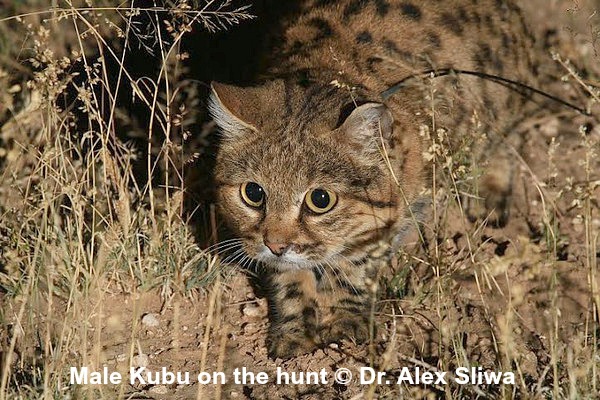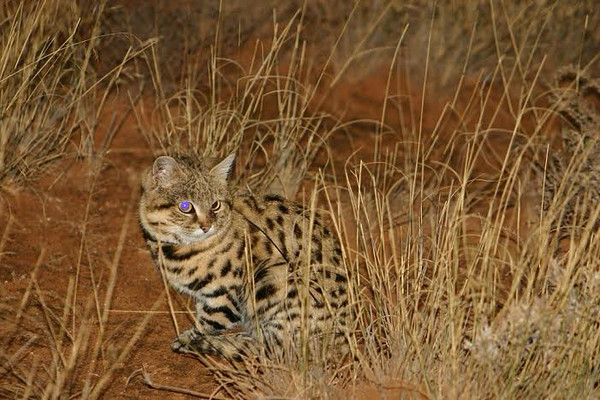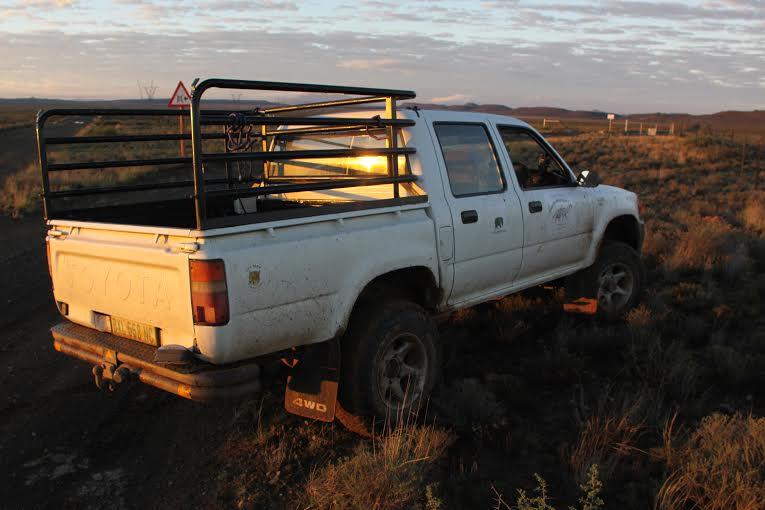In the harsh desert environment of South Africa lives a very tiny wild cat. Adult male black-footed cats weigh less than five pounds, or 2.5 kg, making them one of the smallest wild cat species in the world. Theirs is a world of arid climate, temperature extremes, vast hunting areas and constant danger from larger carnivores.
Black-footed cats are no bigger than your house cat, and probably smaller in most cases. They are only found in three countries: Botswana, Namibia and South Africa.
An incredibly tenacious little cat, the natives have a legend claiming these tiny cats can bring down a giraffe. While this is untrue, it pays homage to the determination of these feisty little felines.
Researchers often record interactions between black-footed cats and other animals in their habitat. Their attitude proves that while they may be small, they don’t let their size stop them!
“The male Kubu was located resting in a hollow termite mound. When he became active, he sprayed several times, then caught a gerbil. He continued to forage and as a group of bat-eared foxes three times the size of the cat approached, Kubu sat and watched them. When one of the foxes came too close, Kubu slapped him and just walked on.”
Or how about this determined kitty:
“I was following one of the black-footed cats when I drove past a blue crane nest I had been checking the past week. This time when I shone my spotlight on the big birds, I noticed the bright blue eyes of the male black-footed cat next to the nest. I watched as he sniffed the nesting female’s head and neck, then tried to push underneath her to get to the chicks in the nest.”

Their Population is Decreasing
In addition to natural threats like black-backed jackals, caracals and eagle owls, these cats are increasingly being challenged by human changes to their habitat.
The average black-footed cat eats about 3,000 rodents each year. This should earn them the title of Farmer’s Friend, but they face many man-made threats:
-Poisoning of carcasses to kill larger carnivores, which the black-footed cats scavenge
-Overgrazing by livestock, which reduces their prey base
-Poisoning of locusts, which are eaten by the cats in huge numbers
-Killing by domestic dogs, which are used to chase or dig out jackals
With their population rapidly declining, this field project is vitally important so we can learn how to reverse this trend.
Why We Need You
To study these nocturnal little felines, first you have to find them at night, in the vast desert. Team members drive a nightly route of up to 50 miles (80 km) along dirt roads at a speed under 18 mph (30 km) per hour while looking for the characteristic bright blue eye-shine of the cats. A minimum of two people stand on the open back of the vehicle operating two spotlights.
The project’s old 4×4 truck is on it’s last tires. With nearly 400,000 km of looking for black-footed cats on the odometer, it is spending more time in the costly repair shop than on the road.
When this truck stops working, the project stops learning about the cats. A new vehicle would cost more than $40,000 US but with your help, we can keep the cats under focus for half that price!
This is your chance to help us make a difference for these smallest of wild cats, and we ask for your support. Even if you’re not in a position to make a donation, please help us spread the word. Tell your friends, tell your family, share it on your social media, shout it from the rooftops, hire a skywriter… OK maybe not the last one, but you get the idea. Pass it on, and encourage your friends to do the same!
Please share this campaign wherever you can, and let everyone know you stand as a voice for the smallest of wild cats. Together, we CAN make a difference!
Help Save Africa’s Smallest Wild Cat

